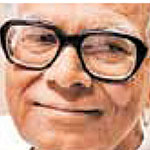For a new science and art of a meaningful co-relation between state and civil movements
 By Prakash N Shah
By Prakash N Shah
(Veteran civil society activist based in Ahmedabad; editor of Gujarati journal ‘Nireekshak’)
It is true that home minister Sushilkumar Shinde called him ‘yeda’, or mad, chief minister, and our protagonist, Arvind Kejriwal, too identified himself as anarchist. It is then understandable if people ask: can you imagine a chief minister on protest fast? Governance is among the two or three buzzwords these days, and somebody can well point out that a government cannot be run from the streets; let’s see how well you can govern.
But if we discount the whole AAP phenomenon like this, we will be able to make sense of neither history in the making nor the process of history going through its ups and downs, twists and turns. From Jantar Mantar via Tahrir Square to this day, what we have been witness to in these two or three years is that an anonymous crowd swarming the streets can transform suddenly into Jan Virat and a charged-up civil society can mould governance into new, necessary forms.
Such a process is not a negation of governance or the state. It is a direct warning from the political sovereign (that is, the people) to the legal sovereign (the government) to put governance into government and make the rule of law a just rule. This much should be clear in light of the tradition of the freedom struggle inspired by Gandhi’s satyagraha.
Thirty years after independence, the nation felt the pleasing winds of change when people, so to say, came to power in 1977. This change was made possible thanks to the Jayaprakash Narayan-led campaign against the authoritarianism of a decrepit state.
The maverick Raj Narain had then made a telling remark for prime minister Morarji Desai’s consideration: that Gandhi’s most important legacy is satyagraha, civil noncooperation. Narain had said that now that the country was experiencing the winds of a ‘second swaraj’, why can’t a Gandhian prime minister find a way to create a meaningful relationship between extra-parliamentary satyagrahi methods and government?
Born from the Anna Hazare movement, the AAP phenomenon in this sense shares a link with that second freedom struggle. In fact, in its constantly agitating ways you can see the shades of Trotsky’s ‘Permanent Revolution’ countering the Soviet establishment.
Admitted that we are far from the charisma and influence of a Gandhi-JP-like leadership, comprehensiveness and depth of their movements, and the explosive, creative possibilities they ignited. Yet, in spite of its limitations, what is happening across the country after the AAP came to power in Delhi is very much on the Gandhi-JP frequency.
A question that was raised back then is now being asked again: why launch direct-action agitations when we finally have representative democracy?
Well, we need to take a look at political developments across the globe before posing this question. Navajivan, or resurgence, is not possible without putting those in their place who swear by status-quo and look at any agitation with the dog-in-the-manger attitude. Civil agitations, then, are possibly like that young woman in a Kalidas play whose kick revived the Ashoka tree and made it bloom again. The political elite, for its own sake, should appreciate this role of civil agitations.
There is certainly a role for democratic institutions that enjoy constitutional status. But from time to time, these institutions seem devoid of sensitivities and can be perceived as anti-people. In such times, people coming out on the streets can prepare a ground for a course correction even if that is extra-constitutional. Students of political science would point out that John Rawls’s insistence on total reliance on constitutional bodies has not remained as acceptable as before.
If we step back in history, for a long time, Montesquieu’s ‘Spirit of the Laws’ has been the ruling theory on separation of powers. These powers are the legislative, the executive and the judiciary. But it would be unfortunate if our definition of democracy was limited to only these institutions, because all three have to find direct or indirect support from – who else but – people. The sage in Shatpath Brahman put it so beautifully when he told the king, “O ruler, the roots of your power are in your people.”
So, the question is, whether you will limit your debate to these institutions or expand its ambit. If you limit yourself to institutions, well, you will remain limited.
A new science and a new art of a meaningful co-relation between the ruling establishment and the civil agitation awaits a new Gandhi.
(This column appeared in the February 1-15 anniversary issue of the print magazine – CHANGE: India on the move)
